iPhone imaging: Mercury, Jupiter;
StarLock Polar Drift Align
Posted: 25 April 2016
Here is a photo of the Meade 12" LX600 telescope installed on the Pier-Tech 1 pier taken with the D7200 DSLR and 8mm fisheye lens:
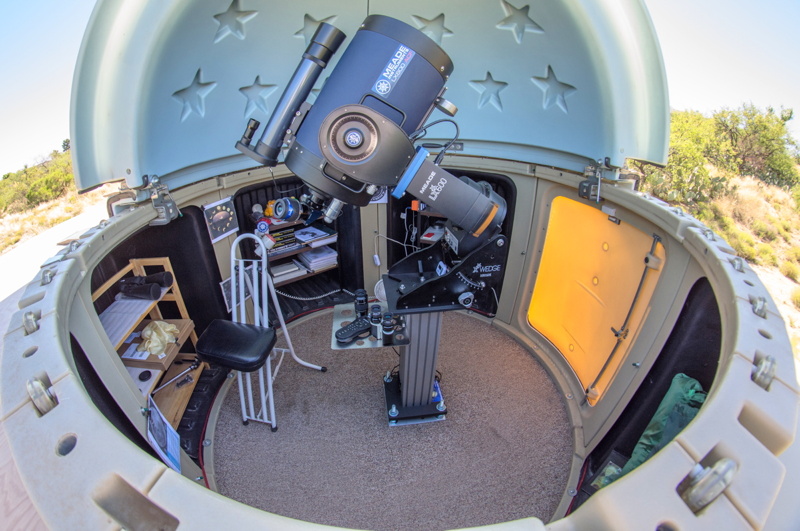
With the completion of the three planned observatory upgrades, Cassiopeia Observatory seems like a new spaceship!
A bobcat stopped by our home for a drink during the day on Sunday, 24 April 2016:
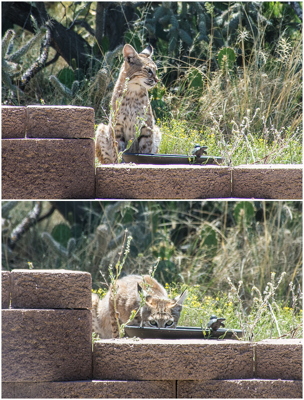
Click or tap on image for larger version
|
Open: Sunday, 24 April 2016, 1833 MST Temperature: 84°F |
Session: 953 Conditions: Mostly clear, hazy, breezy |
Synced observatory clock to WWV. 1902 MST: sunset (behind clouds). 12" LX600 ON, StarLock OFF. Viewed Mercury, 102X. Crescent phase visible. Switched to a 1.25" 26mm eyepiece + 3X TeleXtender and mounted the iPhone 6s Plus on the telescope using the SteadyPix Universal Smartphone Telescope Photo Mount. Used the earbuds volume control as a remote shutter release. This is a stack of 2560 video frames taken with the iOS Camera app, slo-mo (240 fps), afocal 281X:

Mercury was low in the sky by the time I got things set up for imaging so the crescent phase does not appear as nice as it did earlier.
1923 MST: viewed Jupiter, 94X. Three moons were visible. Next, I moved the dome off onto the PZT. Added the 3X TeleXtender for a nice view of Jupiter at 281X. Mounted the iPhone using the SteadyPix adapter. This is how Jupiter appeared "live" on my Apple Watch using the Camera app:
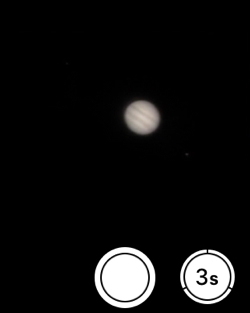
I then did some slo-mo (240 fps) video recordings of Jupiter, afocal 281X. This is a stack of 2505 video frames:
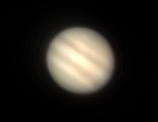
The Great Red Spot is just barely visible at the lower right on the Southern Equatorial Belt as it was rotating into view.
1950 MST: ended imaging. Switched to the 2" 9mm 100° eyepiece (271X) and viewed Jupiter. Good view at times.
1957 MST: viewed M42 (the Great Orion Nebula), 102X, for maybe the last time this Spring as it is getting low in the southern sky after the end of Astronomical Twilight. 2005 MST: the Zodiacal Light was also visible in the western sky. Then viewed the Leo Triplet of Galaxies (M65, M66, and NGC3628), 102X, all three of which were in the same field-of-view. Really nice view.
2015 MST: StarLock ON. Began setting up to do the StarLock aided Polar Drift Alignment to properly align the telescope mount to the Earth's axis now that the telescope has been permanently mounted on the new pier. 2020 MST: began the drift alignment. The telescope automatically slewed to a star in the southern sky and the StarLock camera began monitoring its drift. After 190 seconds of monitoring the AutoStar handcontroller display showed this:

What that was telling me was that the StarLock determined that no adjustment of the wedge Azimuth position was necessary. My initial Polar Alignment (using the AutoStar One Star alignment) done on the previous session must have been pretty good.
The telescope then slewed to a star in the eastern sky and began monitoring it. After just a few seconds it reported this:

That told me that some adjustment in elevation (Latitude correction) was needed and that I should rotate the wedge elevation knob about half a turn counterclockwise. But was that CCW as seen from the south or north side of the mount? I decided that I should stand on the south and look at the knob. I rotated the knob about half a turn CCW and told the StarLock to repeat the east star drift check. After monitoring the drift for about 170 seconds, it reported:
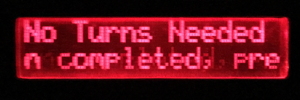
2042 MST: ended the StarLock Polar Drign Alignment. Using the StarLock to polar align the mount was really slick. When I had the 8" LX200-ACF telescope in the observatory I would manually do polar drift alignments by monitoring south and east stars using an illuminated reticle eyepiece. If any star drift was seen the wedge was adjusted a small amount and the drift monitoring repeated. This could take an hour or more to get a precise alignment. The StarLock made it simple.
I had planned to do StarLock Right Ascension (RA) Periodic Error Correction (PEC) training this session but the wind was increasing. I decided to defer this to a future session. 2053 MST: StarLock OFF.
Took a final look at Jupiter, 102X. The Great Red Spot was now near the planet's central meridian. Switched to 271X; the view of Jupiter was good during brief moments of steady seeing. The wind was getting strong now so began closing up for the night.
|
Close: Sunday, 24 April 2016, 2113 MST Temperature: 64°F |
Session Length: 2h 40m Conditions: Clear, windy |
I am now on Facebook. You can find me at "Mike Weasner".
Comments are welcome using Email. Twitter users can use the button below to tweet this report to your followers. Thanks.
Cassiopeia Observatory Home Page
Copyright ©2016 Michael L. Weasner / mweasner@me.com
URL = http://www.weasner.com/co/Reports/2016/04/25/index.html
